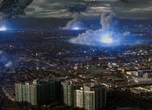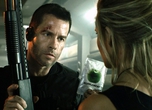The Hobbit: An Unexpected Journey
Peter Jackson goes into TV mini-series mode with his latest Tolkien epic

© 2012 Warner Bros. Ent. TM Saul Zaentz Co.
Posted: Tue Dec 11 2012
Director: Peter Jackson
Starring: Martin Freeman, Ian McKellen, Richard Armitage
Time Out rating: 
Japanese title: Hobbit: Omoigakenai Boken
Size isn’t everything, but cinema doesn’t come much bigger in scale than when Peter Jackson is telling tales. It’s a decade since the New Zealand filmmaker unveiled the last of his Lord of the Rings films and went on to tackle the ultimate in movie giants, King Kong. Now he’s back in the head of JRR Tolkien and applying the latest in technology to The Hobbit: An Unexpected Journey (3D and an untried, super-speedy frame rate of 48 frames per second – 24 is usual). It’s the first of three films to be fashioned from the professor’s novel of faux-medieval fantasies chronicling how a magic ring (‘the precious’) came to be in the possession of a mere hairy-footed Hobbit in the first place.
The movie may be grand, but lots of its folk are tiny, which makes for unusual juxtapositions, both odd and amusing. Bilbo Baggins (Martin Freeman, squished) is a Hobbit living the pipe-and-slippers dream in the Shire. One evening, the wizard Gandalf (Ian McKellen, towering over the artificially shortened Freeman) and 13 itinerant, hungry dwarves – many of them with a knack for annoying the audience – come knocking. They persuade Bilbo to join them on a quest to win back their lost kingdom from a dragon. So begins a journey across wild terrain and back-to-back run-ins with larger, more vicious creatures. And all the while Bilbo is wondering what the hell he’s got himself into.
Many have wondered exactly how Jackson and his co-writers have found three movies in the relatively slim pickings of Tolkien’s early novel (compared to the later novels of the Rings trilogy). The answer is that he opts for the detail and pacing of an extended TV series – an approach that has its drawbacks over more than two-and-a-half hours. The initial coming-together of Bilbo and the dwarves feels overlong, and the start of their journey is sluggish and lacks a vital sense of forward momentum. There’s a problem of tone, too, as the early dominance of slapstick, knockabout comedy gives the whole thing an alienating whiff of kids’ TV (not helped by the softly-softly, artificial look of the set for the Shire). Only a flashback showing the brutal loss of the dwarves’ kingdom reminds us how breathtaking and alive these films can be.
It’s during the film’s final third that, at last, we feel a true sense of peril and the dwarves’ journey starts to feel energetic and purposeful. The big turning point is the entry of Gollum. The more dark and sinister things get, the more The Hobbit becomes compelling as a story, and achieves a tone and look that feel right. It doesn’t help that the earlier, lighter scenes (lighter in look, as well as atmosphere) appear overexposed. Or that even the outdoor scenes seem rooted on a studio set – a knock-on, you assume, of the fast frame rate, which sometimes reflects the experience of watching a movie on a more shoddy HD TV.
Thanks Hobbitses for Gollum, then. And thank Hobbitses for the film’s more involving later scenes, including a showdown between two stone giants and an encounter with a villain who gives Jabba the Hutt a run for his money in the beauty stakes. It’s scenes such as these that leave you looking forward to the next one rather than wanting to strangle one of the more annoying dwarves, or at least bury him in a hole and leave him behind in the Shire.
The Hobbit: An Unexpected Journey opens nationwide on December 14
Tweets
- About Us |
- Work for Time Out |
- Send us info |
- Advertising |
- Mobile edition |
- Terms & Conditions |
- Privacy policy |
- Contact Us
Copyright © 2014 Time Out Tokyo














Add your comment